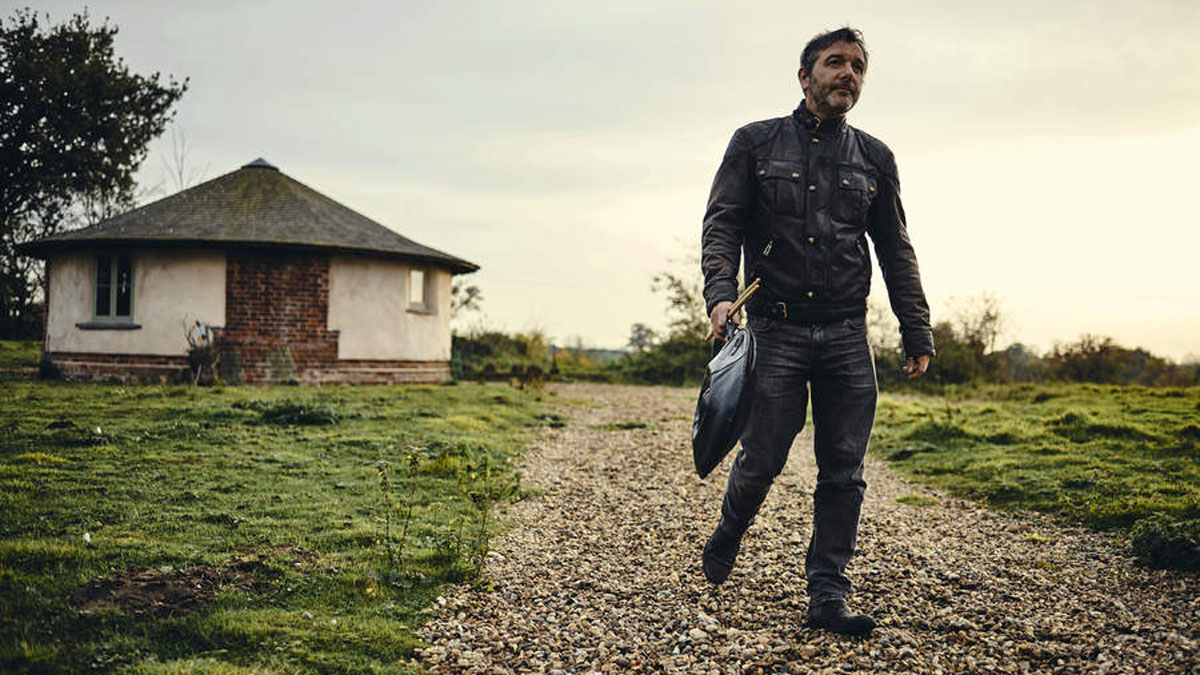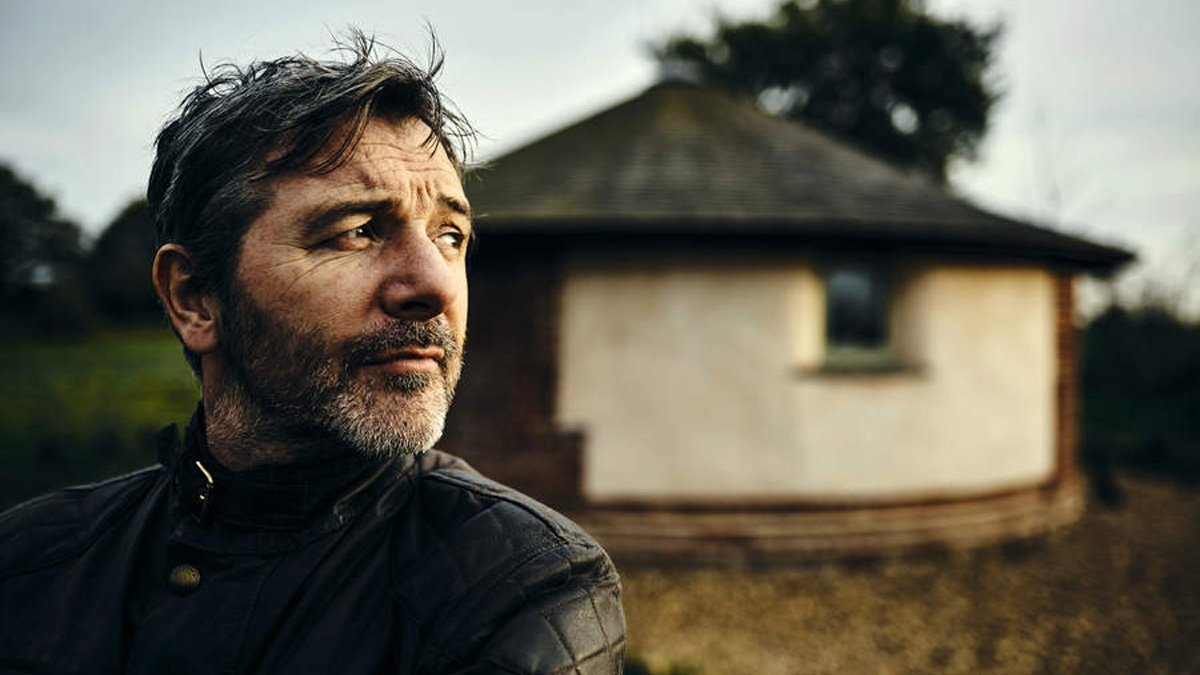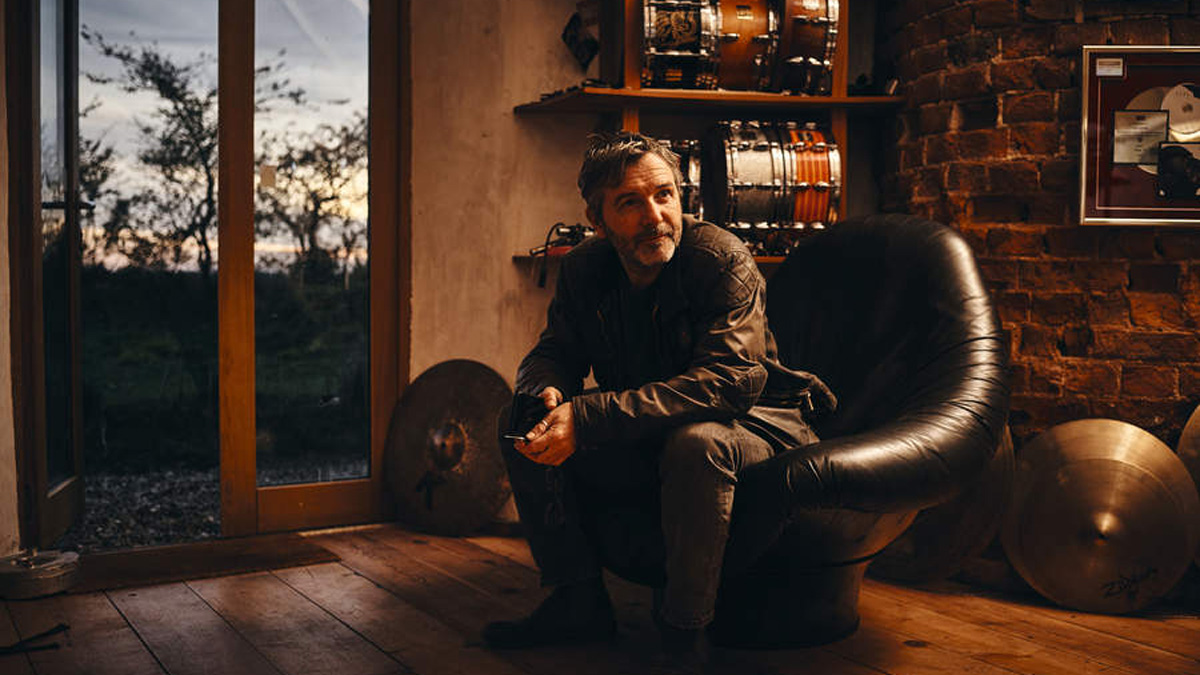Ash Soan talks revolutionising the drum session world from his back garden: “This place was basically built to get my crap out of the house"
Session hero on home studios, The Voice and much more

Inside The Voice star's home studio
Interviewing session drummers in their natural environment has always meant a trip into London to one of the major studios dotted throughout the city.
It’s curious, then, to be heading towards the open space, greenery and pig farms of rural Norfolk for our latest assignment - interviewing renowned British session drummer Ash Soan.
You see, whilst Ash earned his session stripes laying down his tasteful groove for acts such as Adele, CeeLo Green and James Morrison in London’s busiest studios, a few years ago he made the brave decision to move much of his work closer to home - into his back garden to be exact.
The result is The Windmill, a converted mill-turned-drum recording haven just a stone’s throw from his front door. While the ’Mill’s magical drum sound was more a happy accident than a calculated career move, Ash’s investment and dedication to the project has already paid dividends.
With the blessing of producers such as Trevor Horn, Stephen Lipson, Steve Power and Mark Taylor, drum tracks recorded at The Windmill have received Grammy nominations, featured on hits for Seal, Jeff Lorber, Paul Jackson Jr and Rumer and even been the soundtrack to fellow-drummer Jamie Oliver cooking up a storm on his Quick And Easy Food show.
The studio has become the undoubted star of Ash’s buzzing Instagram channel, too - 110,000 followers (and counting) tune in regularly to bear witness to that signature groove, pore over the ’Mill’s amazing sound, and study Ash’s sonic experiments with mics and gear. And the most amazing part of all? There are no additional engineers miking the kit or running the sessions from a control room.
Over many years spent in studios, and with a little help from his muso friends, Ash has learned to engineer, rig mics, record and mix himself solo, something he sees as an increasingly valuable skill in any musician’s arsenal. An indication of where sessions are headed? He certainly thinks so, and undoubtedly the results speak for themselves.
Trevor [Horn] goes, ‘So, who puts the microphones on the drums?’ I told him I did and it freaked him out
For Ash, a major perk of owning a home studio is being able to spend more time with the family, but between sessions for pop acts and film scores, kicking off his fifth series of The Voice, clinic tours and more, he clearly has no intention of slowing down.
The diary for 2018 is already filling up, and Ash has longer-term plans to teach and host exclusive drum camps at The Windmill, complete with tents and campfires! Perched on a soft leather couch beside Ash’s trusty Gretsch Broadkaster, and with golden autumn sunshine pouring through the glass doors of The Windmill, it’s time to quiz the session superstar on his studio investment, the future of drum sessions, the power of social media and how The Voice changed his stance on reading notes…
Fun session today for @mixedbychopz at @thewindmillstudio #WindmillSounds #Reggae Ash Soan
A photo posted by @ashsoan on Jan 24, 2018 at 10:58am PST
So Ash, tell us the story behind how you ended up with a professional drum studio so close to home?
“This place was basically built to get my crap out of the house. Producer Mark [Taylor] is a key person really. When I first built it he helped me decide what mics and stuff to get. I knew I had a reputation as a bit of a session guy and I’d played on some records - that bit was sorted - but how was I going to get people to hire me to record at this place?
"Mark said there was really only one way, and that was to have a hit. And then we did! Then we had another one… “I did some stuff on Rumer’s album and that was a hit of sorts, then I did some stuff for Fraser [T Smith, producer] with singer Gavin James, then I did a track on Seal’s new record for Trevor Horn. That was funny. Trevor goes, ‘So, who puts the microphones on the drums?’ I told him I did and it freaked him out, but he’s heard it since and my tracks made it on to the record, so that says it all.
“We did some recording here for Italian singer Laura Pausini. It was Number 1 in Italy and South America, and we were nominated for a Latin Pop Grammy. She didn’t get it, but the drums were recorded here. I did still win that category because I’d done a record with Fraser for a Mexican duo who won it. Seal, Rumer, Jeff Lorber, Grammy nominations, Number 1s; all of a sudden it was working.”
So, aside from the special sound you get in this room, much of its success was down to allies in the industry taking a chance?
“Undoubtedly. It was beautiful that people like Trevor, Mark and Lipson gave a s**t. I did two tracks here for Seal and one of them didn’t make it. We ended up doing that one at Sarm before it went and we used the full extent of the studio. We overdubbed the snare drum in the stairwell, this massive Bonham type thing. There’s no way I could do any of that here. I can do it synthetically, but I don’t have that sound available. Although I have got a valley drum sound [there’s a lush green valley outside the studio door], which I’ve tried!
“This place has got its limitations, but most of the stuff I do, it’s all here. You can definitely get into Bonham world with these mics [points to overheads]. You don’t need much bigger than that.”

Inside The Windmill
Over the years you must have watched countless engineers and producers at work. Is that how you learned to do it yourself?
“I’ve definitely watched the way they approach the drum kit and what they do to it. I remember when I first realised the potential of what compression does. I remember them all talking about it. Oh, they’re compressing the kit, what does that mean? I thought they were doing something like they do with an .mp3 file. Now, knowing what that is, it all starts to make sense. And microphones is another one. The mics I’ve seen for years on my kit I’ve now got myself in my own studio.
“Recording drums is an art form. There are more people now that don’t know how to do it than there were. There’s an engineer that works with Mark called Ren Swan. He’s your classic, brilliant engineer. He’s worked at Sarm and Real World and he knows exactly what he’s doing with 12-plus microphones. But there’s some dudes who just don’t know what to do. Give them this massive instrument with all different sounds and it’s baffling to them.”
Recording drums is an art form
When you started recording at The Windmill, was that the first time you’d got your hands dirty with software like Pro Tools?
“Yeah, absolutely. I’ve learned a lot of it from scratch, and I still don’t really know what the hell I’m doing. And that’s the beauty! There’s a company called Audient and I’ve got some of their mic-pre’s and stuff. They came up to visit – and these guys are good engineers - and I remember talking to Mark and saying, ‘S**t, they’re gonna see what I do and it’s all wrong! They’re going to look at how I’ve got everything patched, what plugins I’m using.’
“Mark quite rightly said that it doesn’t matter how you do it, as long as it makes sense musically and it sounds a certain way. I use YouTube quite a lot - if I am stuck on something and I can’t get through to Mark, I’ll dial it into YouTube and there’s usually somebody telling me what I need to do. Within minutes I’ve fixed the problem.”
Is someone going to hire me to do a gig because of Instagram? At first I thought it wasn’t possible, but now I can cite a few massive ones
Is what you have set up today your go-to rig, including mic positions?
“Generally I just leave it set-up. That’s one of the beauties. I speak to some of the engineers that work with Trevor and that’s the one thing they always go on about - it takes them all day to get a kit sound, then they take it down. Having the gear not moving is a good thing.”
You’re able to produce a very natural drum sound in here. Is that down to a single factor or a combination of everything - the tuning, the drums, the way you play, the room?
“It’s mainly the room I think. We were laughing last night about how lucky I am that it just so happens to sound like this. The chances of it not sounding that good are much higher than it sounding remotely okay.
"There’s no acoustic treatment, there’s no sponge anywhere, no baffles. I wanted to keep it as natural looking a room as possible. And it just so happens that it sounds alright in here.”
You’ve built a major Instagram following over the last few years. Has that generated any work at The Windmill?
“I’ve hit that place where a lot of people are checking out what I’m doing, but is someone going to hire me to do a gig because of Instagram? At first I thought it wasn’t possible, but now I can cite a few massive ones.
"A few years ago I did a gig with Trevor at The Big Feastival with Alex James and Jamie Oliver. I ended up doing double drums with Jamie. I met him, lovely bloke. About two years ago I posted a video and Jamie Oliver commented saying, ‘Oh bruv, love this.’
"I reminded him about the gig with Trevor and we got chatting. I did some promo gigs with Bryan Adams and we happened to do The One Show when Jamie was on, promoting a book.
"Bryan comes back from make-up and goes, ‘Hey Ash, Jamie Oliver’s in make-up, he’s your number one fan, what the f**k!’ Then the door opens and Jamie comes in going, ‘Bruv!’ From there this relationship has built up. He loves this place, he loves the building.
“Eventually, I get a message saying he’s doing this new TV show and, to quote Jamie, ‘It would be great to have some of your grooves while I’m sorting out the scallops.’ I initially sent him some grooves, then I did a bit of library music based on the stuff I was putting up on Instagram, and he’s used it in the show.”

A stellar CV
You’ve made the investment in a great space and you have a sterling CV already. Do you think it’s worthwhile new drummers investing in social media content as a sort of digital business card?
“Forget about social media for a minute… the beautiful thing about recording and about people’s rooms, the way that they approach their drum sound and the way that they play, the combination of all those things, is that there are individuals out there.
"Okay, you may not get that beautiful Vinnie sound like 10 Summoner’s Tales in your bedroom, but you might make a pretty cool noise that might strike a chord with some people. Think about the Amy Winehouse drum sound. It’s a very particular sound - kind of Motown, modern with a foot in the past. You don’t need Abbey Road to do that.
“That’s the thing that excites me. You can get a very cool-sounding vibe from your garage or your shed or your bedroom or whatever. I encourage everybody to do it, because you might just get a cool, dry, amazingly funky little sound. You might sound like Mike Clark with the Headhunters or whatever, and you might strike on a sound.
"If you don’t put it out there who’s going to hear it? If you put it out there someone might see it. My point is that you never know who might be watching. Bernard Purdie has liked my posts on Instagram. What are the chances of that!
“Most recently John Mayer liked one of my posts. I sent him a message just randomly saying thanks for his like and he sent me a message saying he loves my playing. It’s a great way of seeing talent. Obviously there’s a load of stupid stuff, but if you’ve got the time and the energy and filter through then it’s really interesting.”
You’ve clearly got chops, but the majority of the material you post on Instagram is tasteful and stripped-back, the antithesis of the showy stuff that’s out there.
“Some of the playing that’s like that doesn’t translate so well on a phone. I like a groove that’s got a bit of space and has a bit of payoff. I remember listening to Chuck E’s In Love and hearing that Gadd drum fill near the end and going, ‘Oh my god, I want to know how to do that.’
"How do you have a little gap, and then drop this thing that sounds so beautiful? Hopefully, I’m doing that to a degree. Amazingly, that’s a 1970s record, but that sort of thing does translate now.”
You recorded Del Amitri’s Some Other Sucker’s Parade very early in your career. Amazingly, that album is 20 years old now. How have you changed as a player since then?
“That was my first proper major label thing where I’m on all of it. I think I’m a better drummer technically, but most importantly I think I’m better at understanding what that type of artist wants and being able to facilitate it for them and the producer. I’m really glad I’ve accumulated those skills over the years.”
How do you have a little gap, and then drop this thing that sounds so beautiful?
Music styles are constantly evolving. How do you keep on top of that so you can deliver what a producer or artist wants?
“I’m really lucky that I do The Voice. I wouldn’t go and buy 90 percent of the music that I play on that show or knowingly go and listen to a Justin Bieber record, but I have to know it. A groove that’s absolutely dominant in the charts at the moment is that dancehall thing. That’s a groove that I learned years ago, but it’s everywhere; different speeds, different values of swing. That show absolutely forces me to listen to music that I wouldn’t normally. If I was left to my own devices I’d just sit in here listening to Steely Dan!”
Do you still find recording drums challenging or have you reached a point where you’re completely confident in what to play?
“I think I’ve got more confidence now. The interesting thing about confidence is that if you have it, it instills it in others. If you can play something well enough and make it come across well it instills that confidence in other people. There’s definitely challenges still. Some of the more modern ways of playing I find difficult sometimes - this whole thing where it’s half swung, half straight, I find that really hard. Or not playing with the bass.
“That’s a definite thing where the drummer’s straight and the bass player’s swung. They’re not ignoring each other, but the tension that’s created between the two parts is quite a new thing for rhythm sections. I’ve spent my whole life with my right foot trying to be stapled to the bass player’s notes. All of a sudden someone might tell you not to. That’s hard, but I’m getting my head round it. The challenge that I’m liking the most now is when people go, ‘I want you to play on this track and this is the sound we want.’ They want me to actually find and recreate that noise. It’s really cool.”
Has the process of getting gigs changed since you entered the session world?
“Back then it was more on a grassroots level. People would see you at gigs and on gigs. But the principles are the same now. Do you turn up on time, are you cool, can you play, are you a nice person to be around? All of those things are exactly the same, and I think people will get work the same way I got work. You turn up on a gig, meet some new people, play well, they will remember you and then the thing keeps revolving hopefully.”
Would you agree that there’s more competition for fewer gigs now?
“I think there are definitely more musicians. There’s more colleges and places that are churning those guys out, but I think the work’s good. Less than 10 years ago the music business was on a bit of a sticky wicket regarding streaming.
"The labels have sorted that out and they are looking at earning more money than they did in the 80s. We shouldn’t be worried. People say, ‘No one’s selling any music, there’s no money anymore.’
"I’m telling you now, there’s honestly as much, if not potentially more, money than there’s ever been because they’ve figured out streaming. It’s working for the labels.
"Now what we hope is that the artists get sorted out and it trickles down to us humble tub thumpers. Which I think it will. I really do think the future’s bright for guys that get into the business.”

The importance of reading...
You’re on your fifth season of The Voice now. What does the gig entail?
“It’s spread out over a few months. We start in September where we’ll go in as a band and we’ll start routine-ing the blind songs. It’s always over a hundred songs. We have one week as a band to get that together then in the second week the acts come in with us. It’s a ridiculous amount of work. People go, ‘Yeah, they’re only 90 seconds long,’ but there’s still 100 different vibes. Take Roxanne by The Police; you might know it, but you won’t know this version because the edit can be anything, it could start on the chorus.”
There must be a lot of reading involved, something you’d not focused on until recently?
“I spent a lot of my time not really reading music, arguably all my career. Then I got asked to do The Voice and it was a reading gig. My reading was okay. Like nearly every drummer, I knew what the basics looked like, but as far as actually reading charts I never really did it. Over the five years of The Voice I’ve forced myself to sight read, but that also means making mistakes.
“Luckily, I’ve got a really great relationship with David Tench the MD. Two years ago, at this stage of the blind auditions, I said I wasn’t going to prepare. He looked at me like I was a nutter! We all share a Dropbox and edits and charts go in there before we even go into rehearsals so you can have a look through and a listen before we start. I decided I wasn’t going to do that, I was just going to do it on the day. We’d do 18 songs a day and I threw myself in at the deep end, which meant that I would make mistakes.
I spent a lot of my time not really reading music, arguably all my career. Then I got asked to do The Voice and it was a reading gig
“Luckily, I’d instilled enough confidence in Dave that I would be okay when it came to doing it the following week. I’m glad I did because it massively helped my reading, to the point where all of a sudden other doors opened. I did the Terminator Genisys soundtrack with Ian Thomas, and that led onto me doing Kung Fu Panda 3. I would have said no to all of that, but The Voice gave me the confidence to say yes. Then I got through those sessions and now I’d consider myself a reader.”
Has the regularity of The Voice meant that you’ve been able to be more picky with work?
“I worked too much [last] year. The summer is when I get quite a big break, but lots of things came up. I went to Japan with Trevor Horn, I did a clinic tour with Zildjian, it was my second year doing the 21 Drums camp with Mark Guiliana and Mike Johnston in Ireland. All these things ran into each other, and I had some sessions too. Before I knew it my summer had just disappeared.
“It’s almost impossible to say no. There’s an enormous chunk of my life early in my career where I wanted to say yes to everything and I had to say yes to everything, and it gets ingrained in your psyche that you can’t let a job go, a) because of the money, and b) if you let that door close somebody else might get your gig.”

I'm MusicRadar's eCommerce Editor. In addition to testing the latest music gear, with a particular focus on electronic drums, it's my job to manage the 300+ buyer's guides on MusicRadar and help musicians find the right gear for them at the best prices. I dabble with guitar, but my main instrument is the drums, which I have been playing for 24 years. I've been a part of the music gear industry for 20 years, including 7 years as Editor of the UK's best-selling drum magazine Rhythm, and 5 years as a freelance music writer, during which time I worked with the world's biggest instrument brands including Roland, Boss, Laney and Natal.